Hemlock Well, Spring Lane, Stroud
The sun warmed the air today and it felt good to be outside without the need for masses of clothes. After doing a lot of arrangements for the festival by email and phone, I decided to go to Hemlock Well in Spring Lane to add an image to the 'International Holy Well Month' challenge.
Every one knows this scene of the well, or rather a spring, which is sited at the junction of the ancient Spring Lane and the relatively modern Field Road. I decided to check a book on the local history of Stroud in the 1870s written by Paul Hawkins Fisher, a local lawyer who lived in a large house called The Castle on Castle Street.
I had remembered him writing about the importance of running water supplies to the development of the town centre. So I checked the index and found that not only Hemlock Well was mentioned, but also Gainey's Well, which I will have to investigate another time.
Hemlock Well House is sited at the junction between Spring Lane, which runs uphill to the left of this well, and Castle Street and Lower Street, which I have shown in an 'Extra photo'. Apparently the water from its well was of high quality and is 'much resorted to for its cool clear water by the inhabitants of that part of the old town'.
But I think the original well has 'gone', which I must check by going to the house and asking the owners about it. Fisher also mentions that 'About sixty yards farther down the hill side (ie along Spring Lane) is an old cistern, which was formerly supplied from the same source, and was called Nanny Crocker's Well.' I think the fast flowing water behind the grill in my Blip is the remnant of the piped supply to Nanny Crocker's Well, although now it is commonly, though possibly wrongly referred to as Hemlock's Well. A little research won't take long and I find it fascinating.
Fisher also recounts how:
'in 1840 (when Fisher was quite young) Charles Nichols, a local stonemason, put a ferret into a hole in the cracks of the limestone rocks of a quarry (quite close to where we live) in pursuit of a rabbit. The ferret did not return. But on the next or second day after it was seen to come out of the earth on the wooden spout of a spring, called Hemlock's Well, a quarter of a mile in a direct line from the hole in the rocks which it had entered'.
Spring Lane was the old track going down to Arundell's Mill, and Castle Street and its extension called Lower Street, were the ancient route eastwards out of town, in the direction of Cirencester and London. People would have gone this way to reach the hilltop on the south side of the Golden Valley at Rodborough, from where horse drawn stage coaches would leave regularly for London using the turnpike roads on the flat tops of the Cotswold hills that were easy to navigate.
I've added another couple of 'Extra photos' showing Hemlock Well House, the top of Spring Lane, and the water rushing out of the iron pipe onto the mosses and liverworts.




Comments
Sign in or get an account to comment.


